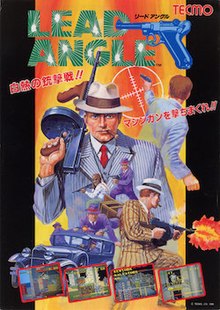
R-Type is a horizontally scrolling shooter arcade video game developed and released by Irem in 1987 and the first game in the R-Type series. The player controls a star ship, the R-9 "Arrowhead", in its efforts to destroy the Bydo, a powerful alien race bent on wiping out all of mankind. The R-9 can acquire a glowing orbicular device called a "Force", protecting it from enemy fire and providing additional firepower. The arcade version was distributed by Nintendo in North America; it is the last arcade title Nintendo distributed.
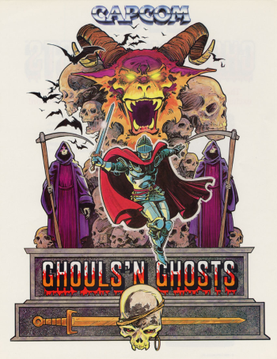
Ghouls 'n Ghosts, known as Dai Makaimura in Japan, is a side-scrolling platform game developed by Capcom, released as an arcade video game in 1988 and ported to home platforms. It is the sequel to Ghosts 'n Goblins and the second game in the Ghosts 'n Goblins series.
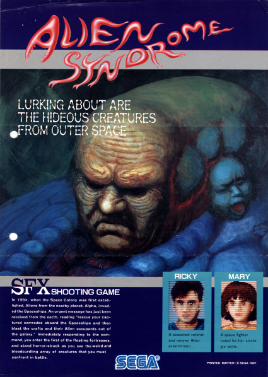
Alien Syndrome is a run and gun video game developed by Sega and released in arcades in 1987, and later ported to the Master System in 1988. The game utilizes a side-scrolling feature that allows the player to take control of either a male (Ricky) or female (Mary) soldier whilst hunting aliens and saving hostages before they run out of time.

Wonder Boy in Monster Land, known by its original arcade release as Wonder Boy: Monster Land, is a platform video game developed by Westone Bit Entertainment and released by Sega in Japanese arcades in 1987 and for the Master System in 1988, with a number of other home computer and console ports following. The game is the sequel to the 1986 game Wonder Boy and takes place eleven years after the events in the previous game. After enjoying over a decade of peace on Wonder Land following the defeat of the evil King by Tom-Tom, later bestowed the title "Wonder Boy", a fire-breathing dragon called the MEKA dragon appeared; he and his minions conquered Wonder Land, turning it into "Monster Land". The people, helpless due to their lack of fighting skill, call for Wonder Boy, now a teenager, to destroy the monsters and defeat the MEKA dragon. Players control Wonder Boy through twelve linear levels as he makes his way through Monster Land to find and defeat the MEKA dragon. Players earn gold by defeating enemies and buy weapons, armor, footwear, magic, and other items to help along the way.

Altered Beast is a 1988 beat 'em up arcade video game developed and published by Sega. The game is set in Ancient Greece and follows a player character chosen by Zeus to rescue his daughter Athena from the demonic ruler of the underworld, Neff. Through the use of power-ups, the player character can assume the form of different magical beasts. It was ported to several home video game consoles and home computers. It was the pack-in game for the Mega Drive when that system launched in 1988.
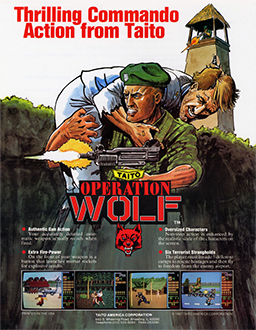
Operation Wolf is a light gun shooter arcade game developed by Taito and released in 1987. It was ported to many home systems.
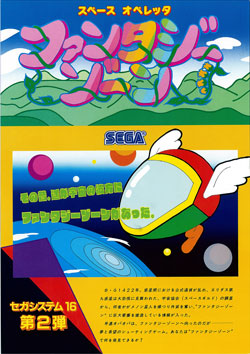
Fantasy Zone is a 1986 arcade video game by Sega, and the first game in the Fantasy Zone series. It was later ported to a wide variety of consoles, including the Master System. The player controls a sentient spaceship named Opa-Opa who fights an enemy invasion in the titular group of planets. The game contains a number of features atypical of the traditional scrolling shooter. The main character, Opa-Opa, is sometimes referred to as Sega's first mascot character.

Commando, released as Senjō no Ōkami in Japan, is a vertically scrolling run and gun video game released by Capcom for arcades in 1985. The game was designed by Tokuro Fujiwara. It was distributed in North America by Data East, and in Europe by several companies including Capcom, Deith Leisure and Sega, S.A. SONIC. Versions were released for various home computers and video game consoles. It is unrelated to the 1985 film of the same name, which was released six months after the game.
Michael Jackson's Moonwalker is the name of several video games based on the 1988 Michael Jackson film Moonwalker. Sega developed two beat 'em ups, released in 1990; one released in arcades and another released for the Sega Genesis and Master System consoles. U.S. Gold also published various games for home computers the same year. Each of the games' plots loosely follows the "Smooth Criminal" segment of the film, in which Jackson rescues kidnapped children from the evil Mr. Big, and incorporates synthesized versions of some of the musician's songs. Following Moonwalker, Jackson collaborated with Sega on several other video games.

Bonanza Bros. is a 3D-style, 2D side-scrolling stealth action game developed and released by Sega in 1990. It is one of the earliest arcade games powered by the Sega System 24 arcade system board. It was ported to various home systems, including the Mega Drive/Genesis, Master System, PC-Engine/TurboGrafx-CD, and several home computers.
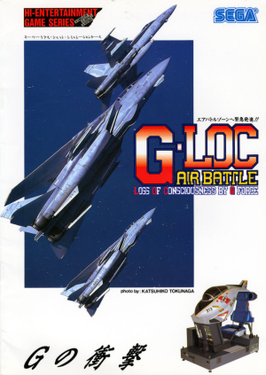
G-LOC: Air Battle is a 1990 combat flight simulator arcade video game developed and published by Sega. It is a spin-off of the company's After Burner series. The title refers to "G-force induced Loss Of Consciousness". The game is known for its use of the R360 motion simulator arcade cabinet. The arcade game was a commercial and critical success upon release.

Forgotten Worlds, titled Lost Worlds in Japan, is a side-scrolling shooter video game by Capcom, originally released as a coin-operated arcade game in 1988. It is notable for being the first title released by Capcom for their CP System arcade game hardware.

Wonder Boy is a 1986 platform game published by Sega and developed by Escape. Originally designed for arcades, it was later ported to the SG-1000, Mark III/Master System and Game Gear video game consoles by Sega, and to the ZX Spectrum, Commodore 64 and Amstrad CPC home computers by Activision. The game is also known as Super Wonder Boy for its Sega Mark III release in Japan and Revenge of Drancon for its Game Gear release in North America. A high definition remake of the game, titled Wonder Boy Returns, was developed by CFK and released on Steam on October 12, 2016. Wonder Boy was rereleased in 2022 as part of Wonder Boy Collection for the Nintendo Switch and PlayStation 4 which includes its versions on arcade, Master System, SG-1000 and Game Gear.

Sega Ninja, originally released as Ninja Princess in Japan, is a run and gun video game released in arcades by Sega in 1985. The game features Princess Kurumi, the titular female ninja, battling enemies using throwing knives and throwing stars. The game was originally released in arcades as Ninja Princess in Japan and Sega Ninja internationally. In contrast to most later games in the genre, Ninja Princess has a feudal Japan setting with a female ninja protagonist who throws shuriken and knives.

Super Monaco GP is a Formula One racing simulation video game released by Sega, originally as a Sega X Board arcade game in 1989, followed by ports for multiple video game consoles and home computers in the early 1990s. It is the sequel to the 1979 arcade game Monaco GP. The arcade game consists of one race, the Monaco Grand Prix, but later ports added more courses and game modes based on the 1989 Formula One World Championship.
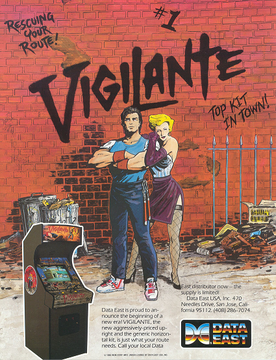
Vigilante (ビジランテ) is a 1988 beat 'em up arcade video game developed and published by Irem in Japan and Europe, and published in North America by Data East. It is considered as a spiritual sequel to Irem's earlier Kung-Fu Master (1984).

Galaxy Force is a rail shooter video game developed and released by Sega for arcades in 1988. The player assumes control of a starship named the TRY-Z, as it must prevent the Fourth Empire from taking over the entire galaxy. Gameplay involves shooting down enemies using either a laser shot or a limited supply of heat-seeking missiles, all while avoiding collision with projectiles or obstacles and making sure the ship's energy meter doesn't fully deplete. It ran on the Sega Y Board arcade system, and was released with a motion simulator cockpit arcade cabinet version like previous Sega Super Scaler games.

Thunder Blade is a third-person shoot 'em up video game released by Sega for arcades in 1987. Players control a helicopter to destroy enemy vehicles. The game was released as a standard stand-up arcade cabinet with force feedback, as the joystick vibrates. A helicopter shaped sit-down model was released, replacing the force feedback with a cockpit seat that moves in tandem with the joystick. It is a motion simulator cabinet, like the previous Sega Super Scaler games Space Harrier (1985) and After Burner (1987). The game's plot and setting was inspired by the film Blue Thunder (1983).

Rastan Saga, known as Rastan in North America, is a side-scrolling hack and slash arcade video game released by Taito in 1987. It was a critical and commercial success and was ported to home platforms.

Night Striker is a 1989 shoot 'em up video game developed and published by Taito for the Taito Z System. In the game, the player flies an armoured car shooting enemy invaders to destroy a terrorist organisation. Night Striker combines gameplay elements of Sega's Space Harrier and Out Run. Versions were released for the Sega Mega-CD in 1993, Sony PlayStation in 1995, and Sega Saturn in 1996. A version was released on the Taito Memories II Gekan compilation for the PlayStation 2 in 2007. Night Striker received mixed reviews, and the Mega-CD version in particular was heavily criticised, primarily due to poor graphics. The music was composed by Taito's Zuntata sound team, and has been released separately.
